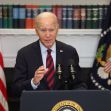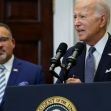A week after the Supreme Court struck down President Joe Biden's student debt relief program, millions of Americans across the nation are grappling with planning their next move forward. Meanwhile, President Biden vows to continue his administration's efforts to help aid student loan borrowers. But what does the high court’s ruling mean and where do borrowers go from here?
The Supreme Court decision came as no shock given the court’s conservative majority and expert predictions on the likely outcome. The court ruled 6-3 in Biden v. Nebraska, with the dissenting minority including liberal Justices Elena Kagan, Sonia Sotomayor, and Ketanji Brown Jackson.
At the heart of the decision was whether the Secretary of Education could forgive student loan debt under the HEROES Act. The act, which was enacted in 2001 after the 9/11 attack on our nation, grants the Secretary of Education power to “waive or modify” statutory or regulatory provisions as they apply to federally granted student financial aid during a time of a national emergency.
It is under this act that the Biden Administration proposed forgiving up to $20,000 of federal student loans for qualifying Americans during the 2019 coronavirus pandemic.
The Supreme Court ruling last week however ruled that such sweeping debt relief was executive overreach and that the Secretary of Education could not apply the HEROES Act in such a broad manner.
Conservative Chief Justice John Roberts, who voted against Biden's loan forgiveness plan and wrote the majority opinion, explained that Secretary of Education Miguel Cardona did not have the authority to “rewrite” the HEROES Act “from the ground up."
"The Secretary's comprehensive debt cancellation plan cannot fairly be called a waiver—it not only nullifies existing provisions, but augments and expands them dramatically. It cannot be mere modification, because it constitutes 'effectively the introduction of a whole new regime,'" Roberts wrote.
The remaining Conservative Associate Justices Clarence Thomas, Samuel Alito, Neil Gorsuch, Brett Kavanaugh, and Amy Coney Barrett all voted with Roberts. Barrett wrote a concurring opinion that explained that in order for Biden's loan forgiveness program to continue forward, it would need congressional approval.
The dissenting justices argued against the conservative majority's opinion that Secretary Cardona overreached his powers under the HEROES Act. The dissent written by Justice Kagan explains that Secretary Cardona was well within the “broad authority” that was provided to him by the HEROES Act and that his actions “fit comfortably within” the Act’s parameters.
What Does the Supreme Court Ruling Mean for Borrowers?
Hours after the ruling, President Biden was clear and straight to the point with his reaction. In a statement from the White House, President Biden explained, “I believe that the Court's decision to strike down our student debt relief plan is wrong. But I will stop at nothing to find other ways to deliver relief to hard-working middle-class families.”
The president pushed back against claims that wide-sweeping student debt relief would disproportionately impact Americans. Opposers of the loan forgiveness program argue that such forgiveness would help college degree holders who were more likely to find higher-paying jobs than Americans who chose not to go to college because of the cost.
Biden has pushed back against similar claims explaining that “Nearly 90 percent of the relief from our plan would have gone to borrowers making less than $75,000 a year, and none of it would have gone to people making more than $125,000.”
In an effort to revive a key campaign promise of eliminating student debt for borrowers who have struggled to pay it off, President Biden shared that his administration will move to forgive student debt through the Higher Education Act of 1965 instead. This act allows the Department of Education the power to “compromise, waive, or release” borrowers from government-backed student loans under certain circumstances. While the Biden Administration has not provided much detail on how loans would be forgiven under this act, the president maintained that the new plan would be legally sound.
Where Do Borrowers Go From Here?
According to the latest data, over 40 million Americans will be required to restart payments on their student loan balances after a more than three-year pause that was triggered by the coronavirus pandemic. While the recent Supreme Court ruling solidified that no relief is coming at least in the near future, borrowers still have some time to plan out their next moves.
Starting on September 1st, interest will resume on federally granted student debt balances, with payments being due in October. For all borrowers, there's still some time to take advantage of interest-free payments, and although it might not make a significant difference, borrowers who are able to make a lump sum payment toward the principal can see all their money go to the principal and not interest.
The Biden administration has also announced a proposed 12-month “on-ramp” approach that will allow borrowers to ease back into their student bait payments. During this 12-month period, borrowers who fail to make a payment will not be considered delinquent and their missed payment will not be reported to credit bureaus, put them in default, or have them referred to a credit collection agency. However, interest will continue to accrue on loan balances even during this on-ramp period.
Borrowers should also keep a close eye on monthly bill payments which they'll receive either in September or October. Additionally, visiting their loan service providers' websites will also offer more detail on what a borrower owes, interest, and other important information they’ll need to be aware of.






